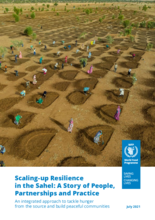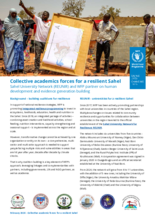
WFP is boosting resilience at scale in the Sahel by restoring land, building community infrastructure, promoting education, improving nutrition and health, and creating jobs for women and young people in the five Sahel countries – Burkina Faso, Chad, Mauritania, Mali and Niger. 4 million people benefited from activities in 2023 in over 3,200 villages, and over 290,000 hectares of land were rehabilitated by Sahelians since 2018.
With the implementation of a Resilience Monitoring and Measurement framework, the programme has exhibited favourable results across various facets including food security, economic empowerment, natural regeneration, nutrition, access to social services, reduction of daily hardships, and promotion of social cohesion. Notably, despite the region facing diverse shocks and stressors alongside a challenging environment marked by a degradation in food security, beneficiaries have largely maintained or improved their food security status in most countries over the years. The programme adopts a multi-sectoral approach aimed at averting humanitarian needs, lessening the impact of economic and climate-related shocks on communities, bolstering the self-reliance of vulnerable countries, and ultimately, nurturing resilience throughout the region.
WFP and partners have embarked on a second phase of the Sahel Integrated Resilience Programme to be implemented over the next five years (2023-2028). This second phase implies: i) adapting support packages to pave the way for resilient food systems before a gradual phase-out; ii) expanding activities to new sites based on landscape continuums; iii) further programme integration, with a particular focus on shock-responsive social protection and disaster risk financing; and iv) reinforce complementarity with partners, particularly to reinforce access to land, energy and water, and strengthen social cohesion.
Consolidating and expanding the approach will require resources aligned with the scale of needs. In total, WFP aims to invest US$1.5 billion in the resilience of 5 million people over the next five years.



